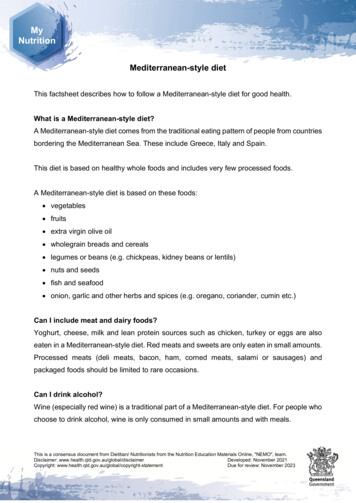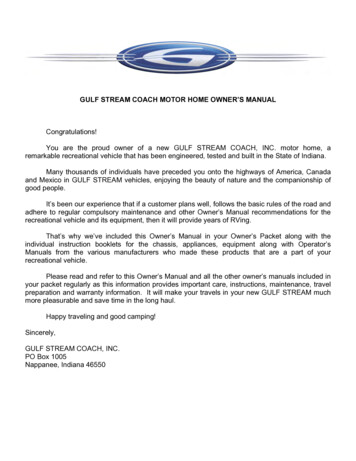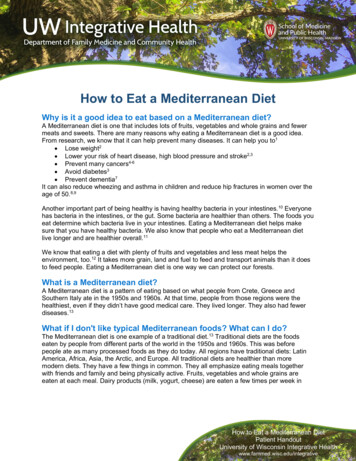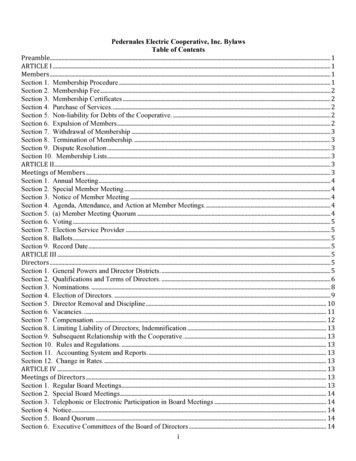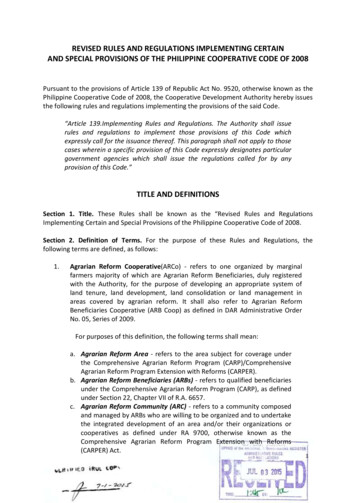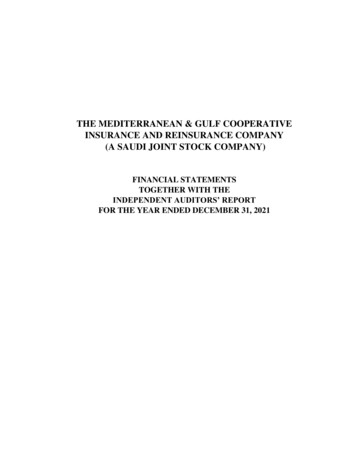
Transcription
THE MEDITERRANEAN & GULF COOPERATIVEINSURANCE AND REINSURANCE COMPANY(A SAUDI JOINT STOCK COMPANY)FINANCIAL STATEMENTSTOGETHER WITH THEINDEPENDENT AUDITORS’ REPORTFOR THE YEAR ENDED DECEMBER 31, 2021
THE MEDITERRANEAN & GULF COOPERATIVE INSURANCE AND REINSURANCE COMPANY(A SAUDI JOINT STOCK COMPANY)INDEXPAGEINDEPENDENT AUDITORS’ REPORT1-7STATEMENT OF FINANCIAL POSITION8-9STATEMENT OF INCOME10STATEMENT OF COMPREHENSIVE INCOME11STATEMENT OF CHANGES IN EQUITY12STATEMENT OF CASH FLOWS13NOTES TO THE FINANCIAL STATEMENTS14-72
THE MEDITERRANEAN & GULF COOPERATIVE INSURANCE AND REINSURANCE COMPANY(A SAUDI JOINT STOCK COMPANY)NOTES TO THE FINANCIAL STATEMENTSFOR THE YEAR ENDED DECEMBER 31, 20211 ORGANIZATION AND PRINCIPAL ACTIVITIESThe Mediterranean and Gulf Cooperative Insurance and Reinsurance Company (the “Company”) is a Saudi Joint StockCompany registered in the Kingdom of Saudi Arabia under Commercial Registration No. 1010231925 dated 8 Rabi Thani1428H (corresponding to 26 April 2007). The registered address of the Company's head office is as follows:Medgulf InsuranceFuturo TowerKing Saud RoadP.O. Box 2302Riyadh 11451, Saudi ArabiaThe objectives of the Company are to transact in cooperative insurance and reinsurance business and related activities in theKingdom of Saudi Arabia. Its principal lines of business include medical, motor and other general insurance. The Companywas listed on the Saudi Arabian Stock Exchange (Tadawul) on 28 Rabi Al-Awal 1428H (corresponding to 16 April 2007).2 BASIS OF PREPARATIONBasis of presentationThe financial statements have been prepared on a historical cost basis except for the measurement at fair value of availablefor sale investments and investment in associates which is accounted for under equity method.Statement of complianceThe financial statements of the Company have been prepared in accordance with ‘International Financial Reporting Standards(IFRS) as endorsed in the Kingdom of Saudi Arabia and other standards and pronouncements issued by the SaudiOrganization for Chartered and Professional Accountants (SOCPA) and the Regulations for Companies in the Kingdom ofSaudi Arabia.As required by Saudi Arabian insurance regulations, the Company maintains separate accounts for Insurance Operations andShareholders’ Operations and presents the financial statements accordingly (refer note 34). The physical custody of all assetsrelated to the Insurance Operations and Shareholders’ Operations are held by the Company. Revenues and expenses clearlyattributable to either activity are recorded in the respective accounts. The basis of allocation of other revenue and expensesfrom joint operations is as determined by the management and Board of Directors.Functional and presentation currencyThe functional and presentational currency of the Company is Saudi Arabian Riyals. The financial statements are presented inSaudi Riyal rounded to nearest thousand (SAR’000) unless otherwise stated.3 SURPLUS DISTRIBUTIONThe Company is required to distribute 10% of the net surplus from insurance operations to policyholders and the remaining90% to be allocated to the shareholders of the Company in accordance with the Insurance Law and ImplementationRegulations issued by the Saudi Central Bank (“SAMA”). In case of losses, losses are absorbed by shareholders.14
THE MEDITERRANEAN & GULF COOPERATIVE INSURANCE AND REINSURANCE COMPANY(A SAUDI JOINT STOCK COMPANY)NOTES TO THE FINANCIAL STATEMENTSFOR THE YEAR ENDED DECEMBER 31, 20214 CHANGES IN ACCOUNTING POLICIESThe accounting policies and risk management policy used in the preparation of the financial statement are consistentwith those followed in the preparation of the Company’s annual financial statements for the year ended 31 December2021, except as explained below:New Standards, Amendment to Standards and Interpretations (adopted by the Company)The Company has applied the following standards and amendments for the first time for their annual reporting periodcommencing 1 January 2021.Amendments to IFRS 7, IFRS 4 and IFRS 16 Interest rate benchmark reform - Phase 2The Phase 2 amendments address issues that arise from the implementation of the reforms, including the replacementof one benchmark with an alternative one. The Phase 2 amendments provide additional temporary reliefs from applyingspecific IAS 39 and IFRS 9 hedge accounting requirements to hedging relationships directly affected by IBOR reform.The Company did not identify a material impact as a result of this amendment.Standards and amendments published but not yet effectiveIFRS 17 – Insurance ContractsThis standard has been published on May 18, 2017, it establishes the principles for the recognition, measurement,presentation and disclosure of insurance contracts and supersedes IFRS 4 – Insurance contracts.The new standard applies to insurance contracts issued, to all reinsurance contracts and to investment contracts withdiscretionary participating features provided the entity also issues insurance contracts. It requires to separate thefollowing components from insurance contracts:i. embedded derivatives, if they meet certain specified criteria;ii. distinct investment components; andiii. distinct performance obligations to provide non-insurance goods and services.These components should be accounted for separately in accordance with the related standards (IFRS 9 and IFRS 15).MeasurementIn contrast to the requirements in IFRS 4, which permitted insurers to continue to use the accounting policies formeasurement purposes that existed prior to January 2015, IFRS 17 provides the following different measurementmodels:The General model is based on the following “building blocks”:a) the fulfilment cash flows (FCF), which comprise: probability-weighted estimates of future cash flows, an adjustment to reflect the time value of money (i.e. discounting) and the financial risks associated with thosefuture cash flows, and a risk adjustment for non-financial risk;b) the Contractual Service Margin (CSM). The CSM represents the unearned profit for a group of insurance contractsand will be recognized as the entity provides services in the future. The CSM cannot be negative at inception; anynet negative amount of the fulfilment cash flows at inception will be recorded in profit or loss immediately. At theend of each subsequent reporting period the carrying amount of a group of insurance contracts is remeasured to bethe sum of: the liability for remaining coverage, which comprises the FCF related to future services and the CSM of the groupat that date;and the liability for incurred claims, which is measured as the FCF related to past services allocated to the group atthat date.the remaining contracts in the portfolio.15
THE MEDITERRANEAN & GULF COOPERATIVE INSURANCE AND REINSURANCE COMPANY(A SAUDI JOINT STOCK COMPANY)NOTES TO THE FINANCIAL STATEMENTSFOR THE YEAR ENDED DECEMBER 31, 20214 CHANGES IN ACCOUNTING POLICIES (Continued)Standards and amendments published but not yet effective (Continued)IFRS 17 – Insurance Contracts (Continued)The CSM is adjusted subsequently for changes in cash flows related to future services but the CSM cannot be negative,so changes in future cash flows that are greater than the remaining CSM are recognized in profit or loss. Interest is alsoaccreted on the CSM at rates locked in at initial recognition of a contract (i.e. discount rate used at inception todetermine the present value of the estimated cash flows). Moreover, the CSM will be released into profit or loss basedon coverage units, reflecting the quantity of the benefits provided and the expected coverage duration of the remainingcontracts in the group.The Variable Fee Approach (VFA) is a mandatory model for measuring contracts with direct participation features(also referred to as ‘direct participating contracts’). This assessment of whether the contract meets these criteria is madeat inception of the contract and not reassessed subsequently. For these contracts, the CSM is also adjusted for inaddition to adjustment under general model; changes in the entity’s share of the fair value of underlying items ,changes in the effect of the time value of money and financial risks not relating to the underlying items.the entity expects a substantial proportion of any change in the amounts to be paid to the policyholder to vary withthe change in fair value of the underlying items.In addition, a simplified Premium Allocation Approach (PAA) is permitted for the measurement of the liability for theremaining coverage if it provides a measurement that is not materially different from the general model or if thecoverage period for each contract in the group is one year or less. With the PAA, the liability for remaining coveragecorresponds to premiums received at initial recognition less insurance acquisition cash flows. The general modelremains applicable for the measurement of incurred claims. However, the entity is not required to adjust future cashflows for the time value of money and the effect of financial risk if those cash flows are expected to be paid/received inone year or less from the date the claims are incurred.Effective DateThe IASB issued an Exposure Draft Amendments to IFRS 17 during June 2019 and received comments from variousstakeholders. The IASB is currently re-deliberating issues raised by stakeholders. For any proposed amendments toIFRS 17, the IASB will follow its normal due process for standard-setting. The effective date of IFRS 17 and thedeferral of the IFRS 9 temporary exemption in IFRS 4,is currently January 1, 2023. Earlier application is permitted ifboth IFRS 15 – Revenue from Contracts with Customers and IFRS 9 – Financial Instruments have also been applied.The Company intend to apply the standard on its effective date.TransitionRetrospective application is required. However, if full retrospective application for a group of insurance contracts isimpracticable, then the entity is required to choose either a modified retrospective approach or a fair value approach.Presentation and DisclosuresThe Company expects that the new standard will result in a change to the accounting policies for insurance contractstogether with amendments to presentation and disclosures.ImpactThe Company is currently in implementation phase of IFRS 17 which requires implementing new processes andprocedures for the business including any system developments required under IFRS 17. Following are the main areasunder implementation phase and status of the progress made so far by the Company:16
THE MEDITERRANEAN & GULF COOPERATIVE INSURANCE AND REINSURANCE COMPANY(A SAUDI JOINT STOCK COMPANY)NOTES TO THE FINANCIAL STATEMENTSFOR THE YEAR ENDED DECEMBER 31, 20214 CHANGE IN ACCOUNTING POLICIES (Continued)Standards and amendments published but not yet effective (Continued)IFRS 17 – Insurance Contracts (Continued)Major areas of implementation phaseSummary of progressGovernance and control frameworkThe Company has put in place a comprehensive IFRS 17governance program which includes oversight steeringcommittee for monitoring the progress of implementation.The Company is in progress of implementing operationalaspects of the design phase which includes establishingcomprehensive data policy and data dictionary. Also theCompany is implementing architectural designs for various subsystems. The Company has progressed through assessment ofbusiness requirementsandcurrently working onimplementation of business requirements.The Company has completed various policy papersencompassing various technical and financial matters afterconcluding on policy decisions required under the IFRS 17standard. The policy decisions are taken after due deliberationsamong various stakeholders. Currently majority of policypapers have been approved by the Company's IFRS 17 projectsteering committee.The Company has developed along with other stakeholders theassurance plan for transitional and post-implementationperiods.Since, majority of the company’s contracts would be measuredunder the premium allocation approach, the impact is expectedto be moderate.Operational areaTechnical and financial areaAssurance planThe Company had started with the implementation process and set up an IFRS 17 steering committee and working group.The Company has completed its first dry run based on certain assumptions and operational simplicity. The Company hasplanned for second dry run for which the deadline is May 31, 2022. Based on the second dry run, management shallevaluate the results and take action accordingly.17
THE MEDITERRANEAN & GULF COOPERATIVE INSURANCE AND REINSURANCE COMPANY(A SAUDI JOINT STOCK COMPANY)NOTES TO THE FINANCIAL STATEMENTSFOR THE YEAR ENDED DECEMBER 31, 20214 CHANGES IN ACCOUNTING POLICIES (Continued)Standards and amendments published but not yet effective (Continued)IFRS 9 – Financial InstrumentsThis standard has been published on July 24, 2014 and has replaced IAS 39. The new standard addresses the followingitems related to financial instruments:a) Classification and measurement:IFRS 9 uses a single approach to determine whether a financial asset is measured at amortized cost, fair valuethrough other comprehensive income or fair value through profit or loss. A financial asset is measured at amortizedcost if both:i.the asset is held within a business model whose objective is to hold assets in order to collect contractual cash flowsandii. the contractual terms of the financial asset give rise on specified dates to cash flows that are solely payments ofprincipal and interest on the principal amount outstanding (“SPPI”).The financial asset is measured at fair value through other comprehensive income and realized gains or losseswould be recycled through profit or loss upon sale, if both conditions are met:i.the asset is held within a business model whose objective is to hold assets in order to collect contractual cash flowsand for sale andii. the contractual terms of cash flows are SPPI,Assets not meeting either of these categories are measured at fair value through profit or loss. Additionally, at initialrecognition, an entity can use the option to designate a financial asset at fair value through profit or loss if doing soeliminates or significantly reduces an accounting mismatch.For equity instruments that are not held for trading, an entity can also make an irrevocable election to present in othercomprehensive income subsequent changes in the fair value of the instruments (including realized gains and losses),dividends being recognized in profit or loss.Additionally, for financial liabilities that are designated as at fair value through profit or loss, the amount of change inthe fair value of the financial liability that is attributable to changes in the credit risk of that liability is recognized inother comprehensive income, unless the recognition of the effects of changes in the liability’s credit risk in othercomprehensive income would create or enlarge an accounting mismatch in profit or loss.b) Impairment:The impairment model under IFRS 9 reflects expected credit losses, as opposed to incurred credit losses under IAS39. Under the IFRS 9 approach, it is no longer necessary for a credit event to have occurred before credit losses arerecognized. Instead, an entity always accounts for expected credit losses and changes in those expected creditlosses. The amount of expected credit losses is updated at each reporting date to reflect changes in credit risk sinceinitial recognition.c) Hedge accounting:IFRS 9 introduces new requirements for hedge accounting that align hedge accounting more closely with RiskManagement. The requirements establish a more principles-based approach to the general hedge accounting model.The amendments apply to all hedge accounting with the exception of portfolio fair value hedges of interest rate risk(commonly referred to as “fair value macro hedges”). For these, an entity may continue to apply the hedgeaccounting requirements currently in IAS 39.This exception was granted largely because the IASB is addressingmacro hedge accounting as a separate project.18
THE MEDITERRANEAN & GULF COOPERATIVE INSURANCE AND REINSURANCE COMPANY(A SAUDI JOINT STOCK COMPANY)NOTES TO THE FINANCIAL STATEMENTSFOR THE YEAR ENDED DECEMBER 31, 20214 CHANGES IN ACCOUNTING POLICIES (Continued)Standards and amendments published but not yet effective (Continued)IFRS 9 – Financial Instruments (Continued)The implementation of IFRS 9 and the examination of its potential impact on the Company’s financials is in progress.The published effective date of IFRS 9 is January 1, 2018. However, amendments to IFRS 4 – Insurance Contracts:Applying IFRS 9 – Financial Instruments with IFRS 4 – Insurance Contracts, published on September 12, 2016,changes the existing IFRS 4 to allow entities issuing insurance contracts within the scope of IFRS 4 to mitigate certaineffects of applying IFRS 9 before the IASB’s new insurance contract standard (IFRS 17 – Insurance Contracts)becomes effective. The amendments introduce two alternative options:1apply a temporary exemption from implementing IFRS 9 until the earlier ofa. the effective date of a new insurance contract standard; orb. annual reporting periods beginning on or after January 1, 2022 following the IASB’s proposal to report theeffective application date of IFRS 17/ IFRS 9 of one-year. Additional disclosures related to financial assets arerequired during the deferral period. This option is only available to entities whose activities are predominatelyconnected with insurance and have not applied IFRS 9 previously; or2adopt IFRS 9 but, for designated financial assets, remove from profit or loss the effects of some of the accountingmismatches that may occur before the new insurance contract standard is implemented. During the interim period,additional disclosures are required.The Company has determined that it is eligible for the temporary exemption option (1). The eligibility conclusion isbased on an analysis of the percentage of the total consolidated carrying amount of liabilities connected with insuranceactivities relative to the carrying amount of all liabilities, which indicates Company’s activities are predominatelyconnected with insurance. Consequently, the Company has decided to defer the implementation of IFRS 9 until theeffective date of the new insurance contracts standard. Disclosures related to financial assets required during thedeferral period are included in the Company’s financial statements.As at December 31, 2021, the Company has total financial assets and insurance related assets amounting to SAR2,329,676 million and SAR 1,036,320 million, respectively. Currently, financial assets held at amortized cost consist ofcash and cash equivalents, short-term fixed deposits, premium and reinsurance receivable and other receivablesamounting to SAR 1,667.24 million (2020: SAR 1,482.29 million). Other financial assets consist of available for saleinvestments amounting to SAR 622.44 million (2020: SAR 590.92 million). The Company expect to use the FVOCIclassification of these financial assets based on the business model of the Company for debt securities and strategicnature of equity investments. However, the Company is yet to perform a detailed assessment to determine whether thedebt securities meet the SPPI test as required by IFRS 9. Credit risk exposure, concentration of credit risk and creditquality of these financial assets are mentioned in notes 33. The Company financial assets have low credit risk as atDecember 31, 2021 and 2020. The above is based on high-level impact assessment of IFRS 9. This preliminaryassessment is based on currently available information and may be subject to changes arising from further detailedanalyses or additional reasonable and supportable information being made available to the Company in the future.Overall, the Company expects some effect of applying the impairment requirements of IFRS 9: However, the impact ofthe same is not expected to be significant. At present it is not possible to provide reasonable estimate of the effects ofapplication of this new standard as the Company is yet to perform a detailed review.19
THE MEDITERRANEAN & GULF COOPERATIVE INSURANCE AND REINSURANCE COMPANY(A SAUDI JOINT STOCK COMPANY)NOTES TO THE FINANCIAL STATEMENTSFOR THE YEAR ENDED DECEMBER 31, 20214 CHANGES IN ACCOUNTING POLICIES (Continued)Standards and amendments published but not yet effective (Continued)Amendment to IFRS 16, ‘Leases’ - COVID-19 related rent concessions Extension of the practical expedientAs a result of the coronavirus (COVID-19) pandemic, rent concessions have been granted to lessees. In May 2020, theIASB published an amendment to IFRS 16 that provided an optional practical expedient for lessees from assessingwhether a rent concession related to COVID-19 is a lease modification. On 31 March 2021, the IASB published anadditional amendment to extend the date of the practical expedient from 30 June 2021 to 30 June 2022. Lessees canselect to account for such rent concessions in the same way as they would if they were not lease modifications. In manycases, this will result in accounting for the concession as variable lease payments in the period(s) in which the event orcondition that triggers the reduced payment occurs.Effective date:Annual periods beginning on or after 1 April 2021.Impact assessmentNo material impact has been identified.A number of narrow-scope amendments to IFRS 3, IAS 16, IAS 37 and some annual improvements on IFRS 1,IFRS 9, IAS 41 and IFRS 16Amendments to IFRS 3, ‘Business combinations’ update a reference in IFRS 3 to the Conceptual Framework forFinancial Reporting without changing the accounting requirements for business combinations.Amendments to IAS 16, ‘Property, plant and equipment’ prohibit a company from deducting from the cost of property,plant and equipment amounts received from selling items produced while the company is preparing the asset for itsintended use. Instead, a company will recognise such sales proceeds and related cost in profit or loss.Amendments to IAS 37, ‘Provisions, contingent liabilities and contingent assets’ specify which costs a companyincludes when assessing whether a contract will be loss-making.Annual improvements make minor amendments to IFRS 1, ‘First-time Adoption of IFRS’, IFRS 9, ‘Financialinstruments’, IAS 41, ‘Agriculture’ and the Illustrative Examples accompanying IFRS 16, ‘Leases’.Effective date:Annual periods beginning on or after 1 January 2022.Impact assessmentNo material impact has been identified.20
THE MEDITERRANEAN & GULF COOPERATIVE INSURANCE AND REINSURANCE COMPANY(A SAUDI JOINT STOCK COMPANY)NOTES TO THE FINANCIAL STATEMENTSFOR THE YEAR ENDED DECEMBER 31, 20215 SIGNIFICANT ACCOUNTING POLICIESThe following is a summary of significant accounting policies followed in preparation of these financial statements:Insurance contractsThe Company issues insurance contracts that transfer insurance risk. Insurance contracts are those contracts where theinsurer accepts significant insurance risk from the policyholder by agreeing to compensate the policyholder if a specifieduncertain future event adversely affects the policyholder. As a general guideline, the Company defines significantinsurance risk as the possibility of having to pay benefits on the occurrence of an insured event that are at least 10% morethan the benefits payable if the insured event did not occur.Cash and cash equivalentsCash and cash equivalents comprise of cash in hand and at banks and short-term time deposits with an original maturityof less than three months at the date of acquisition.GoodwillGoodwill represents the fair value of the consideration paid in excess of the fair value of net assets or liabilities acquired.Goodwill is tested for impairment by management at least once at the end of each financial year. Impairment for goodwillis determined by assessing the recoverable amount of the cash generating unit (or a group of cash generating units) towhich the goodwill is related. When the recoverable amount of the cash-generating unit (or a group of cash generatingunits) is less than the carrying amount of the cash generating unit (or a group of cash generating units) to which goodwillhas been allocated, an impairment loss is recognised. Impairment losses, if any, relating to goodwill cannot be reversed infuture periods.Land, property and equipmentLand is stated at cost less any impairment and is not depreciated. Property and equipment are measured at cost lessaccumulated depreciation and any impairment in value. Cost includes expenditure that is directly attributable to theacquisition of the asset. Depreciation is charged to the statement of insurance operations and accumulated surplus on astraight line basis at the following depreciation rates:Rates15% - 25%10% - 15%25%25%Class of AssetsLeasehold improvementsOffice equipment, furniture and fixturesComputersMotor vehiclesAny gain or loss on disposal of an item of property, plant and equipment (calculated as the difference between the netproceeds from disposal and the carrying amount of the item) is recognised in statement of incomeThe assets’ residual values and useful lives are reviewed at each reporting date and adjusted if appropriate. The carryingvalues of these assets are reviewed for impairment when event or changes in circumstances indicate that the carryingvalue may not be recoverable. If any such indication exists and where the carrying values exceed the estimatedrecoverable amount, the assets are written down to their recoverable amount.Intangible assetsIT development and software is shown at historical cost. It has a finite useful life and are subsequent carried at cost lessaccumulated amortization and impairment losses. The Company amortises intangible assets with a limited useful lifeusing straight-line method over the following periods:Years15% - 25%IT development and software21
THE MEDITERRANEAN & GULF COOPERATIVE INSURANCE AND REINSURANCE COMPANY(A SAUDI JOINT STOCK COMPANY)NOTES TO THE FINANCIAL STATEMENTSFOR THE YEAR ENDED DECEMBER 31, 20215 SIGNIFICANT ACCOUNTING POLICIES (Continued)InvestmentsAll investments are initially recognised at fair value, being the fair value of the consideration given, including acquisitioncharges associated with the investment except for investments at fair value through profit or loss. Premiums and discountsare amortized on a systematic basis to their maturity. For investments that are traded in organized financial markets, fairvalue is determined by reference to exchange quoted market bid prices at the close of business on the statement offinancial position date without any deduction for transaction costs.(a) Available for sale investmentsInvestments which are classified as "available for sale" are subsequently measured at fair value. Available for saleinvestments are those investments that are not held to maturity nor held for trading. For an available for sale investmentwhere the fair value has not been hedged, any unrealized gain or loss arising from a change in its fair value is recogniseddirectly under insurance operations’ surplus and / or shareholders' comprehensive income until the investment isderecognized or impaired at which time the cumulative gain or loss previously recognised under the insurance operations’surplus and / or shareholders' comprehensive income is included in the statement of insurance operations andaccumulated surplus and / or shareholders' operations for the year. Available for sale investments whose fair value cannotbe reliably measured are carried at amortised cost less impairment provision.(b) Investments in held to maturity securitiesInvestments which have fixed or determinable payments that the Company has the positive intention and ability to hold tomaturity are subsequently measured at amortized cost, less provision for impairment in value. Amortized cost iscalculated by taking into account any discount or premium on acquisition. Any gain or loss on such investments isrecognised in the statement of income - shareholders' operations when the investment is derecognized or impaired.(c) Investment in an associateAssociates are enterprises in which the Company generally holds 20% to 50% of the voting power and / or over which itexercises significant influence. Investments in an associates are carried in the statement of financial position at cost, pluspost acquisition changes in the Company’s share of net assets of the associate, less any impairment in the value ofindividual investments.Statutory reserveIn accordance with its bylaws, the Company shall allocate 20% of its net income from shareholders’ operations each yearto the statutory reserve until it has built up a reserve equal to the share capital. The reserve is not available fordistribution. In view of the accumulated losses, no such transfer has been made for the year ended 31 December 2021.Impairment and un-collectability of financial assetsAn assessment is made at each statement of financial position date to determine whether there is objective evidence that afinancial asset or group of financial assets may be impaired. If such evidence exists, any impairment loss is recognized inthe statement of shareholders’ operations. Impairment is determined as follows: For assets carried at fair value, impairment is the difference between the cost and fair value (fair value being lowerthan cost), less any impairment loss previously recognized in the statement of shareholders’ operations. For assets carried at cost, impairment is the difference between the cost and the present value (present value beinglower than cost) of future cash flows discounted at the current market rate of return for a similar financial asset. For assets carried at amortized cost, impairment is determined based on future cash flows that are discounted at theoriginal effective special commissio
The objectives of the Company are to transact in cooperative insurance and reinsurance business and related activities in the Kingdom of Saudi Arabia. Its principal lines of business include medical, motor and other general insurance. . the liability for remaining coverage, which comprises the FCF related to future services and the CSM of the .




